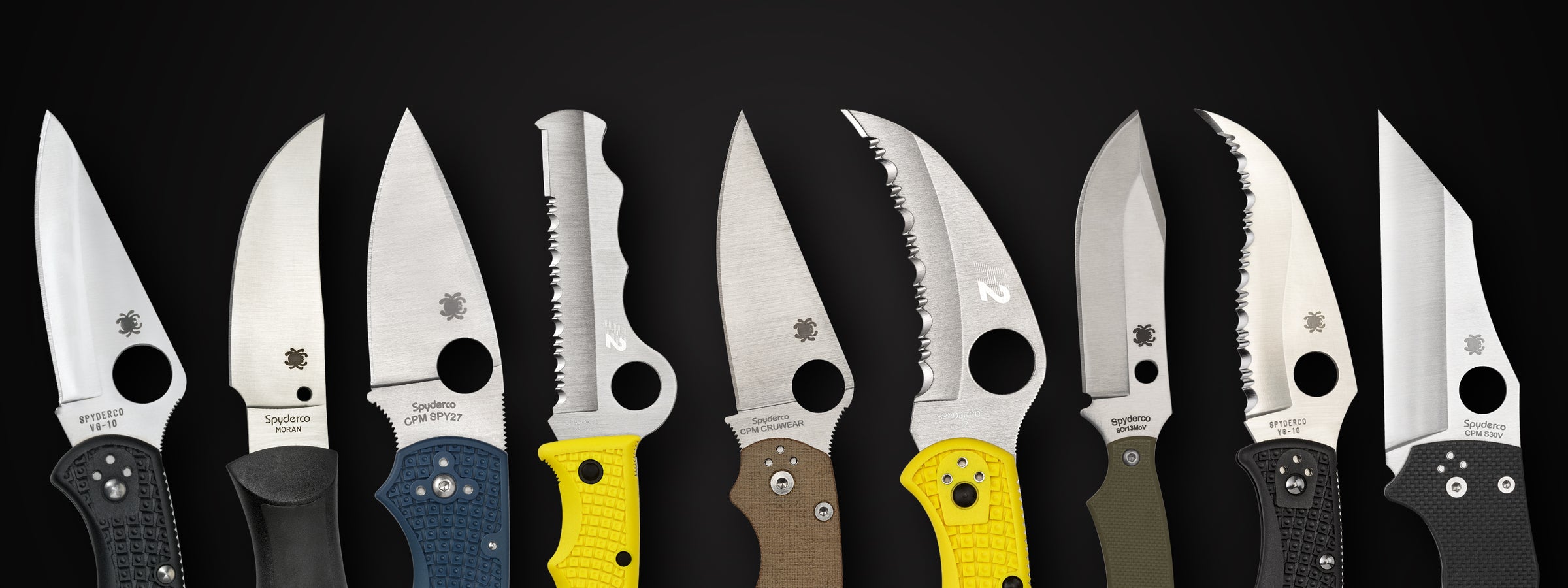Blade Shapes
The shape of a knife’s blade defines its performance characteristics and suitability for specific tasks. As one of man’s oldest tools, knives have also evolved to become one of our most specialized. Spyderco’s broad range of designs leverages both traditional blade profiles and modern designs to optimize both the performance and aesthetics of our knives across a wide range of real-world applications. Understanding the origins, influences, and intended applications of various blade profiles is a critical aspect of becoming a knowledgeable knife enthusiast.

Assist Blade
Specific to Spyderco’s Assist model, this highly refined blade shape accentuates the features of a traditional sheepfoot profile for enhanced safety and versatility. Developed for first responders as a rescue tool, it features a hollow-ground blade with a blunt, rounded tip to prevent accidental punctures. Its CombinationEdge™ cutting edge excels at cutting rope, seatbelts, clothing, and webbing during rescue situations where precision and safety are critical.

Bowie Blade
Named for the legendary Colonel James Bowie, this iconic blade shape generally features a sweeping belly and a clipped point. The clipped section may be sharpened or unsharpened and may be either straight or curved. Many variations of the Bowie pattern exist.

Double-Edged Blade
As its name implies, this style of blade features two sharpened edges. It may be symmetrical and the edges of equal length—like a classic dagger—or asymmetrical with edges of different lengths. Double-edged blades increase a knife’s usable edge area and enhance its penetration when used to thrust.

Drop Point Blade
Popularized by legendary knifemaker Bob Loveless, this blade shape features a gently sloping spine that curves convexly to the point. It is preferred by many hunters because it reduces the chances of accidentally puncturing an animal’s entrails during field dressing.

Hawkbill Blade
A deeply curved blade with the edge on the concave side, the hawkbill profile “gathers” the material being cut. It excels at cutting fibrous materials like rope, line, and netting and is therefore popular in commercial and marine use. This shape also allows extremely focused cutting and piercing pressure with the blade tip.

Leaf-Shaped Blade
A signature Spyderco profile, the leaf-shaped blade resembles the profile of a bamboo leaf. It offers a balanced combination of belly, or convex curve to the edge, while maintaining an acute, well-centered point.

Modified Clip Point Blade
A variation of the classic clip point, this blade shape features a long, straight spine that angles downward to the tip. It provides an acute, well-centered, but durable point and is ideal for general use.

Revers "S" Blade
This blade shape combines a convex, hawkbill-style profile near the tip with a convex belly near the “heel” or base of the edge. The result is an edge profile that resembles a backward “S” curve. This unique geometry creates an aggressive cutting dynamic and an exceptionally acute point, making it a potent design for both self-defense and precise utility tasks.

Sheepfoot Blade
Characterized by a straight edge and a rounded, blunt tip, the sheepsfoot blade greatly reduces the risk of accidental punctures. Ideal for trimming hooves and working around livestock, it was also the traditional choice of mariners.

Spear Point Blade
In this symmetrical blade shape, the spine and edge curve equally to meet at the centerline. Spear point blades often feature swedges or false edges to create a more acute point, reduce cutting friction, and enhance penetration.

Tanto Blade
A traditional Japanese tanto was a short, fixed-blade knife with a full guard. In its modern form, pioneered by custom knifemaker Bob Lum, it is a knife blade shape with the angular tip style of a Japanese katana (long sword).

Wharncliffe Blade
This profile features a straight cutting edge and a spine that slopes or curves gradually downward to an acute point. This geometry allows the blade to cut with full power all the way to the tip, while providing an exceptionally fine point that excels at detail work.


